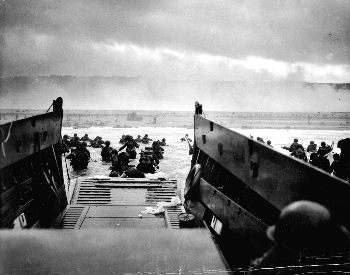
- Battle Name: Normandy Landings (D-Day)
- Battle Start Date: June 6th, 1944
- Battle End Date: June 6th, 1944
- Battle Belligerents: Nazi Germany, United States, Britain and Canada
- Battle Winner: Allies (United States, Britain and Canada)
- Total Casualties: 11,000+
20 Normandy Landings Facts for Kids
- The Normandy Landings was the invasion of Nazi occupied Europe during World War 2.
- The Normandy Landings was fought between Nazi Germany and the Allies (United States, Britain and Canada).
- The Normandy Landings was started and ended on June 6th, 1944.
- The Normandy Landings was the largest seaborne invasion in the history of military warfare.
- The codename for the Normandy Landings was Operation Neptune, however it’s commonly referred to as D-Day.
- The Normandy Landings were a success and the Allies (United States, Britain and Canada) won.
- The Allies success with the Normandy Landings gave them a beachhead in Nazi occupied Europe.
- At the start of the Normandy Landings the Allies had over 320,000 military personnel, 126 landing craft, 1,213 warships, 864 merchant vessels, and 736 ancillary craft.
- At the end of the Normandy Landings the Allies had over 10,000 casualties.
- At the start of the Normandy Landings Nazi Germany had over 50,000 military personnel and 170 costal artillery guns.
- At the end of the Normandy Landings Nazi Germany had around 1,000 casualties.
- D-Day was originally scheduled for June 5th, 1994. However, the weather conditions forced Allied commanders to delay the invasion for 24 hours.
- Over 13,000 American paratroopers from the 82nd and 101st Airborne Divisions were dropped behind enemy lines. Their goal was to capture bridges, road crossings, and other important objectives.
- Bad weather conditions caused many paratroopers to miss their targeted drop zones over Normandy. However, this helped the Allies because it confused the Germans.
- There were seven beaches targeted during the Normandy Landings and they were the Sword Beach, Juno Beach, Gold Beach, Omaha Beach, Utah Beach and Pointe du Hoc.
- Omaha Beach was the bloodiest of all the landing points with an estimated 2,000 casualties.
- Utah Beach was the easiest for the Americans to take due to the light German defenses.
- Pointe de Hoc wasn’t a beach, but a-100 foot cliff. Allied troops had to scale the cliff to take out German artillery batteries, however they discovered they weren’t they after they climbed up. After searching the area, they found five of the six artillery guns and destroyed them.
- The Allies were able to successfully transport almost 160,000 soldiers across the English Channel on D-Day.
- Operation Bodyguard was a deception campaign used by the Allies to fool the Germans into thinking their invasion was going to happen at a different location.
Normandy Landings Pictures

A picture of the Allies preparing for the Normandy Invasion in Britain.Credit: Photo by Nehez. SC206438

A picture of paratroopers just before heading out out to invade Normandy.Credit: National Archives. RG-208-MO-10H

A picture of U.S. soliders on a landing craft on the coast of France.Credit: SC320901

A picture of the first wave at Omaha beach on D-Day in Normandy.Credit: CG 2343

A picture of U.S. troops landing on Utah Beach on D-Day.Credit: Wall. SC189902

A picture of the Allies beachhead in France on June 6th, 1944.Credit: Photo by Steck. SC190631
Find More Facts About the Normandy Landings
- A Timeline of the Normandy Landings – Discover key events, dates and places from the Normandy Landings on the Military History website.
- History of the Normandy Landings (D-Day) – Read about the history of the Normandy Landings on the U.S. Military website.
- Pictures from the Normandy Landings – View pictures taken during the Normandy Landings on the New York Times website.
- Normandy Landings – Wikipedia – Find more facts and information about the Normandy Landings on the Wikipedia website.
